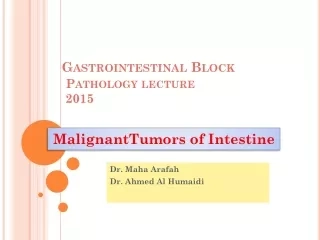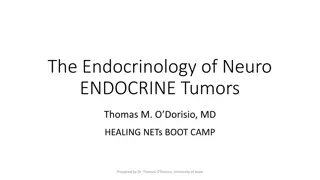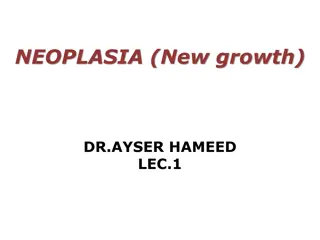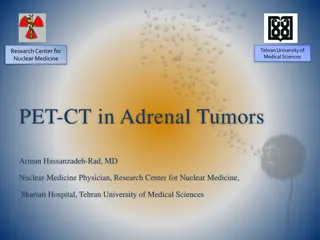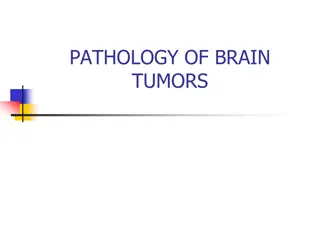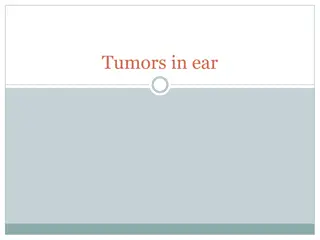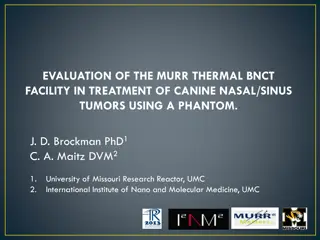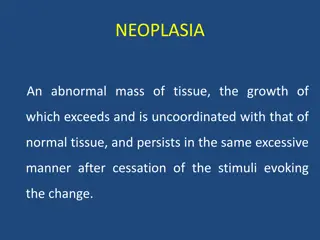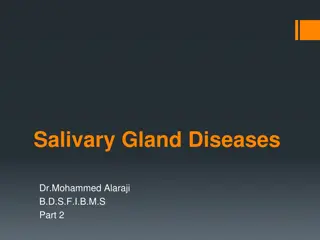Classification of Tumors: A Comprehensive Overview
Understanding the classification of tumors is crucial in the field of pathology. This detailed overview covers the definitions of neoplasia and tumors, the differentiation between benign and malignant tumors, nomenclature, and characteristics of various tumor types. It discusses the behaviors of benign and malignant tumors, including their potential clinical consequences. The importance of the tumor components - parenchyma and stroma - in determining the biological behavior of tumors is also highlighted.
Download Presentation

Please find below an Image/Link to download the presentation.
The content on the website is provided AS IS for your information and personal use only. It may not be sold, licensed, or shared on other websites without obtaining consent from the author. Download presentation by click this link. If you encounter any issues during the download, it is possible that the publisher has removed the file from their server.
E N D
Presentation Transcript
CLASSIFICATION OF TUMORS Dr. Maria A. Arafah Assistant Professor Department of Pathology http://fac.ksu.edu.sa/mariaarafah/courses
2 06/11/2016 Path 211 Objectives Definitions: neoplasm, tumor, oncology. Classification of tumors into benign and malignant. Nomenclature of tumors. Characteristics of benign and malignant tumors. Definitions: teratoma, hamartoma, choristoma.
3 06/11/2016 Definitions Neoplasia: literally means newgrowth. A neoplasm often is referred to as a tumor, and the study of tumors is called oncology (from oncos, tumor, and logos, studyof ).
4 06/11/2016 Classification ofTumors The division of neoplasms into benign and malignant categories is based on their potential clinical behavior.
5 06/11/2016 Classification ofTumors Benign: the microscopic and gross characteristics of the lesion are considered to be relatively innocent. Tumors remain localized. Tumors are amenable to local surgical removal. Patients generally survive.
6 06/11/2016 Classification ofTumors Malignant: lesions can invade and destroy adjacent structures and spread to distant sites (metastasize) to cause death.
7 06/11/2016 Classification ofTumors All tumors, benign and malignant, have two basic components: The parenchyma, made up of transformed or neoplastic cells. The supporting, host-derived, non-neoplastic stroma, made up of connective tissue, blood vessels, and host-derived inflammatory cells. 1. 2.
8 06/11/2016 Classification ofTumors The nomenclature of tumors and their biologic behavior are based primarily on the parenchymal component. However, the growth and evolution of tumors is critically dependent on their stroma as an adequate stromal blood supply is a requisite for the tumor cells to live and divide.
9 06/11/2016 Nomenclature of Tumors - Benign Benign tumors are designated by attaching the suffix - oma to the cell type from which the tumor arises. The nomenclature of mesenchymal tumors usually apply this rule e.g. Fibroma: a benign tumor arising in fibrous tissue. Chondroma: a benign tumor arising in cartilaginous tissue. Osteoma: a benign tumor arising in bone tissue.
10 06/11/2016 Nomenclature of Tumors - Benign The nomenclature of benign epithelial tumors is more complex: cell of origin, microscopic pattern or macroscopic appearance. Adenoma is generally applied to benign epithelial neoplasms producing gland patterns and to neoplasms derived from glands but not necessarily exhibiting glandular patterns.
11 06/11/2016 Nomenclature of Tumors - Benign Benign epithelial neoplasms producing microscopically or macroscopically visible finger-like or warty projections from epithelial surfaces are referred to as papillomas.
12 06/11/2016 Nomenclature of Tumors - Benign Benign epithelial neoplasms forming large cystic masses, as in the ovary, are referred to as cystadenomas. Some of the latter produce papillary patterns that protrude into cystic spaces and are called papillarycystadenomas.
13 06/11/2016 Nomenclature of Tumors - Benign Cystadenoma Macroscopically Cystadenoma Microscopically
14 06/11/2016 Nomenclature of Tumors - Benign Papillary cystadenoma Macroscopically Papillary cystadenoma Microscopically
15 06/11/2016 Nomenclature of Tumors - Benign A polyp is a mass that projects above a mucosal surface, as in the gut, to form a macroscopically visible structure.
16 06/11/2016 Nomenclature of Tumors - Malignant Malignant neoplasms arising in mesenchymal tissues are called sarcomas. Fibrosarcoma: a malignant tumor arising in fibrous tissue. Chondrosarcoma: a malignant tumor arising in cartilaginous tissue. Osteosarcoma: a malignant tumor arising in bone tissue.
17 06/11/2016 Nomenclature of Tumors - Malignant Malignant neoplasms arising from epithelial cells are called carcinomas. Carcinomas include: Carcinomas that arise from glandular epithelial cells (with or without forming glands): adenocarcinomas Carcinomas that arise from squamous cells (some producing keratin): squamouscellcarcinomas. Carcinomas that show little or no differentiation: poorly differentiatedorundifferentiatedcarcinoma.
18 06/11/2016 Nomenclature of Tumors - Malignant Squamous cell carcinoma Adenocarcinoma
19 06/11/2016 Nomenclature of Tumors Not infrequently, however, a cancer is composed of undifferentiated cells of unknown tissue origin, and must be designated merely as an undifferentiatedmalignant tumor.
20 06/11/2016 Nomenclature of Tumors The transformed cells in a neoplasm, whether benign or malignant, often resemble each other, as though all had been derived from a single progenitor, consistent with the monoclonal origin of tumors. In some unusual instances, however, divergent differentiation of a single neoplastic clone along two lineages occurs, creating the so-called mixedtumors.
21 06/11/2016 Nomenclature of Tumors The best example is the mixed tumor of the salivary gland. These tumors have obvious epithelial components dispersed throughout a fibromyxoid stroma, sometimes harboring islands of cartilage or bone. All of these diverse elements are thought to derive from a single clone capable of giving rise to epithelial cells or myoepithelial cells, or both, and the preferred designation for these neoplasms is pleomorphicadenoma.
22 06/11/2016 PleomorphicAdenoma Macroscopically Microscopically
23 06/11/2016 Nomenclature of Tumors Some glaring inconsistencies may be noted. For example, the terms lymphoma,mesothelioma,melanoma, and seminoma are used for malignant neoplasms.
24 06/11/2016 Teratoma Teratoma is a special type of mixed tumor that contains recognizable mature or immature cells or tissues representative of more than one germ cell layer and sometimes all three. Teratoma originates from totipotential cells such as those normally present in the ovary and testis and sometimes abnormally present in sequestered midlineembryonic rests. Such cells have the capacity to differentiate into any cell type found in the adult body.
25 06/11/2016 Teratoma When all the components within the teratoma are well differentiated, it is a benign(mature)teratoma. However, when they are less differentiated, it is an immature, potentially or overtly, malignantteratoma.
26 06/11/2016 Teratoma Macroscopically Microscopically
27 06/11/2016 Hamartoma Hamartoma is a mass of disorganized benign-looking tissue indigenous to the particular site. For example, pulmonarychondroidhamartoma, which contains islands of disorganized, but histologically normal cartilage, bronchi, and vessels. Hamartomas have traditionally been considered developmental malformations, but some genetic studies have shown the presence of acquired translocations, suggesting a neoplastic origin.
28 06/11/2016 Choristoma Choristoma is a congenital anomaly consisting of a heterotopic rest of cells. For example, a small nodule of well-developed and normally organized pancreatic tissue may be found in the submucosa of the stomach, duodenum, or small intestine. Choristoma has usual trivial significance.
29 06/11/2016 Summary Although the terminology of neoplasms is regrettably not simple, a firm grasp of the nomenclature is important because it is the language by which the nature and significance of tumors are categorized.
30 06/11/2016 Summary
31 06/11/2016 Summary
32 06/11/2016 Summary
33 06/11/2016 Reference Kumar V, Abbas AK, Aster JC. Robbins Basic Pathology. 9th ed. Elsevier; 2013. Philadelphia, PA.
34 06/11/2016 END OF LECTURE Thank You


